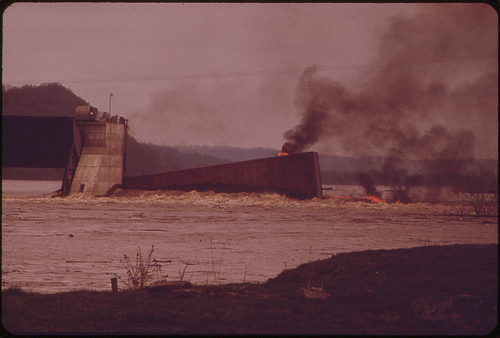By: Eira Tansey

Strode, William, “Burning Barge on the Ohio River”, 1972, Environmental Protection Agency: DOCUMERICA. Image source: https://catalog.archives.gov/id/543983
The relationship between local, state, and federal environmental protection has always been complicated – both by accident and by design. When the earliest environmental protections began, they typically started at the local and state levels, often following some kind of environmental disaster – and thus, environmental protections developed unevenly. By the time, the federal Environmental Protection Agency (EPA) was created in 1970, the decentralization of environmental policy was deliberately embedded in the original organization of the agency: much of EPA’s enforcement and regulatory duties are delegated to state environmental agencies.
Water issues have been roiling the Midwest, with significant attention paid to the Flint lead crisis and the construction of the Dakota Access pipeline. Ohio’s water issues may not be in the headlines as much, but the risks are worth paying attention to. Ohio is often described as a “water-rich” state with Lake Erie to the north, and the Ohio River to the south. Although we may be water-rich, this water is often quite contaminated. The Ohio River is consistently ranked as the most polluted river in the United States, and UC researchers have conducted studies of pollutants from Ohio River-sourced drinking water supplies connected with past manufacture of Teflon. Both Lake Erie and the Ohio River routinely experience harmful algae blooms, which are often connected to runoff from agricultural activities – and much harder to regulate. In addition, Cincinnati is under a federal consent decree due to the overflow from infrastructure deficiencies with the local sewer system.
So what connection do water issues have to recordkeeping, libraries, and archives? An underappreciated aspect of environmental protection is that much of it depends on the availability of certain types of information found only in federal, state, and municipal agency records. Environmental regulations require significant amounts of recordkeeping, including monitoring, sample reports, permits, violation notices, licenses, registries, annual reports, complaints, and remediation agreements. Reliable records kept over long periods of time are critical to establishing “baseline” levels of land and water health, and records created for other purposes – such as medical records of employees working in high-risk industries – demonstrate how environmental contaminants affect public health.
Several agencies and departments in Ohio oversee environmental management activities, but the two big ones are the Ohio Department of Natural Resources and the Ohio Environmental Protection Agency. Ohio DNR oversees oil and gas regulation, as well as management of state parks, forests, and wilderness areas. Ohio EPA carries out water and air pollution regulation as mandated by federal EPA.
Where can one find Ohio agency environmental records and publications? There are 3 main places:
- On the agency website itself (Ohio EPA makes many of its records searchable online)
- At the State Library of Ohio
- At the Ohio History Connection
You can also consult Ohio environmental law guidebooks, which can be helpful for understanding the many acronyms and references to state law and administrative code when reviewing agency environmental records.
The old saying in the environmental community is to “think globally, act locally.” Many of the most pressing environmental issues of our day – climate change, water scarcity, the erosion of public resources for private profit – are global issues that have highly localized manifestations. Robust local and regional recordkeeping efforts are critical to protecting the air, soil and water resources of the Ohio Valley region. Unfortunately, much of this information is hard to track down, or fairly obscure for the average citizen. What’s important to remember is that the vast majority of these records are public records, and citizens have the right to access these records as part of their right to know.
